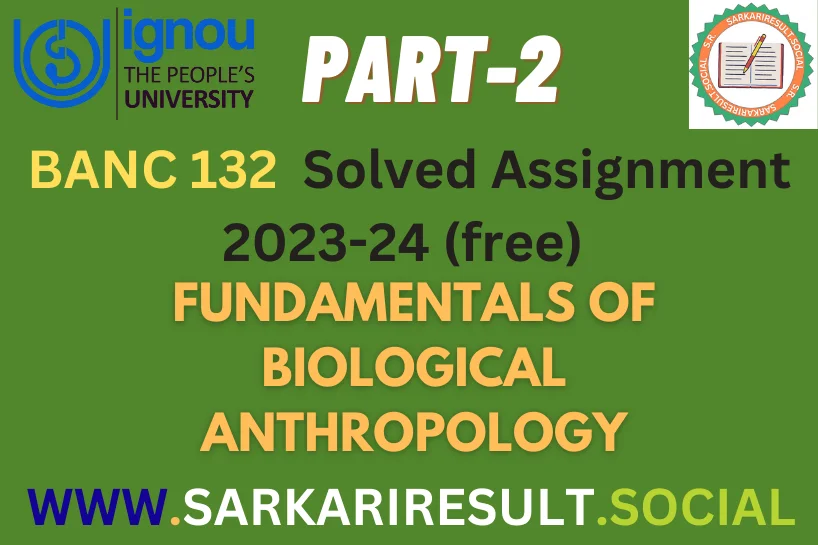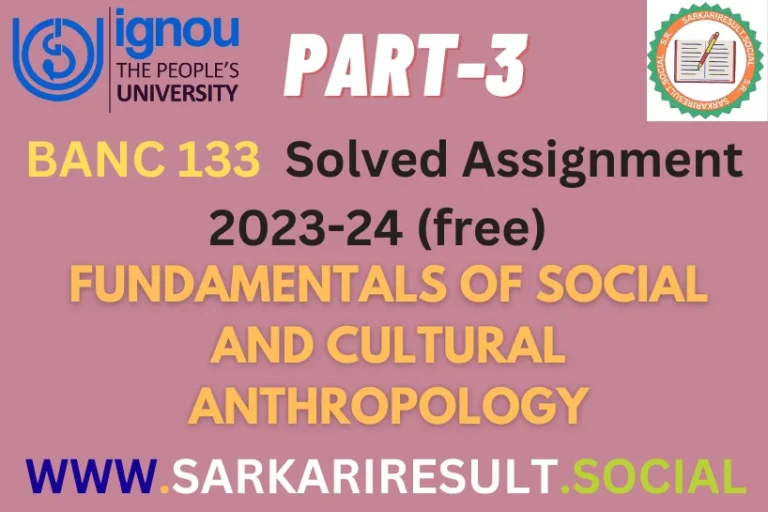BANC 132 IGNOU Solved Assignment 2023-24 (free) Part-2

BANC 132 IGNOU Solved Assignment 2023-24 (free) Part-2
“Continue your exploration of Biological Anthropology of BANC 132 IGNOU Solved Assignment 2023-24 (free) Part-2. In this section, you’ll delve into primate characteristics, the connection between physical anthropology and human genetics, and the intriguing methods used to study human variation. These concise responses, about 250 words each, will deepen your knowledge and help you solve IGNOU assignments 2023-24.”

Q.3 Discuss in brief primate characteristics.
Ans. Primates are a diverse order of mammals that share several key characteristics, setting them apart from other animal groups. These traits reflect their evolutionary adaptations to arboreal (tree-dwelling) lifestyles and complex social behaviors. Here are some of the primary primate characteristics:
BANC 132 IGNOU Solved Assignment 2023-24 (free) Part-1
1. Binocular Vision: Primates typically have forward-facing eyes, providing binocular vision. This overlapping field of vision enhances depth perception, crucial for navigating through trees and accurately judging distances.
2. Grasping Hands and Feet: Primates possess prehensile hands and feet with opposable thumbs or big toes. This allows them to grasp and manipulate objects, making them adept climbers and tool-users.
3. Dexterous Fingers: The fine motor skills of primates are remarkable. They can pick tiny objects, groom one another, and manipulate tools with great precision.
4. Reduced Olfactory Sense: Compared to many other mammals, primates often have a reduced sense of smell. This is because they rely more on visual and tactile cues in their complex social interactions.
5. Large Brains: Primates typically have relatively large brain sizes compared to their body size. This increased brain complexity is associated with their advanced problem-solving abilities, social behaviors, and learning capacities.
6. Parental Care: Primates exhibit a high degree of parental care. They invest considerable time and effort in raising their offspring, often with extended periods of nursing and teaching.
7. Sociality: Most primates are highly social animals, living in groups with complex social hierarchies. These social structures are essential for protection, cooperation, and the transmission of cultural knowledge.
Check BGDG 172 IGNOU solved assignment 2023-24 (Free)
8. Dietary Flexibility: Primates have a wide range of dietary preferences, from herbivores that primarily consume leaves and fruits to omnivores that include insects and small animals in their diets. This dietary flexibility allows them to adapt to various environments.
9. Slow Reproduction: Primates typically have longer gestation periods and slower reproductive rates compared to many other mammals. This slow reproduction strategy is related to their investment in parental care and the development of complex social structures.
These primate characteristics have evolved over millions of years, reflecting their adaptation to various ecological niches. While these traits unite all primates, the group is also incredibly diverse, with lemurs, tarsiers, monkeys, and apes each exhibiting unique adaptations and behaviors in response to their specific environments. Studying these characteristics provides insights into the evolutionary history of primates and sheds light on our own human lineage.
Q.4 Briefly discuss association of physical anthropology with human genetics.
Ans. Physical anthropology and human genetics are closely intertwined fields that share a common interest in understanding the biological aspects of humanity. They work together to explore the genetic basis of human traits, evolution, and population diversity. Here’s a brief discussion of the association between physical anthropology and human genetics:
1. Human Evolution: Physical anthropology studies human evolution through the examination of fossil evidence, comparative anatomy, and primate behavior. Human genetics plays a critical role in this by providing molecular evidence of evolutionary relationships through the analysis of DNA and genetic markers. Genetic studies help trace our ancestral lineage and understand the genetic changes that have occurred over millions of years.
2. Population Genetics: Human genetics investigates the distribution of genetic variation within and between human populations. This information is essential for physical anthropologists studying human diversity and migration patterns. It helps uncover the genetic similarities and differences among various human groups and provides insights into our evolutionary history.
3. Molecular Anthropology: Molecular anthropology is a subfield that bridges physical anthropology and human genetics. It focuses on using genetic data to investigate questions related to human evolution, migration, and population genetics. DNA analysis of ancient human remains, for example, has revolutionized our understanding of prehistoric human populations.
4. Health and Disease: Both fields contribute to the study of genetic factors in health and disease. Physical anthropologists examine skeletal remains to understand the impact of genetic traits on past populations. Human genetics research identifies genes associated with diseases and conditions, shedding light on their evolutionary history and potential treatments.
Discover BPAG 174 ignou solved Assignment (Free) 2023-24
5. Adaptation and Human Variation: Physical anthropology explores how humans have adapted to diverse environments and climates. Human genetics provides insights into the genetic basis of adaptations, such as lactose tolerance or resistance to specific diseases. Together, these fields illuminate the complex relationship between genetics and environment.
In summary, physical anthropology and human genetics collaborate closely to unravel the biological mysteries of human evolution, diversity, and adaptation. By integrating the study of ancient fossils, comparative anatomy, and genetic data, they contribute to our understanding of our species’ history and the factors that have shaped human biology and genetics. This interdisciplinary approach enriches our knowledge of both the past and present of humanity.
Q.5 Describe methods to study human variation.
Ans. The study of human variation is a crucial aspect of anthropology, genetics, and related fields. It involves examining the differences and similarities among human populations in terms of genetics, physical characteristics, and cultural traits. To investigate human variation, researchers employ a variety of methods:
1. Genetic Analysis: Genetic studies are essential for understanding human variation at the molecular level. Techniques such as DNA sequencing, polymerase chain reaction (PCR), and genome-wide association studies (GWAS) allow scientists to identify genetic markers associated with various traits, diseases, and population differences.
2. Anthropometric Measurements: Anthropometric methods involve taking physical measurements of individuals to assess differences in body size and shape. This includes measuring height, weight, limb lengths, cranial dimensions, and more. Anthropometric data can reveal variations within and between populations.
3. Skin Color and Pigmentation Studies: Researchers examine variations in skin color and pigmentation across populations to understand the genetic and environmental factors that influence these traits. Techniques like spectrophotometry measure skin pigmentation objectively.
4. Cultural Anthropology: Cultural anthropologists study human variation in terms of customs, traditions, languages, and social practices. Ethnographic research involves participant observation, interviews, and fieldwork to document cultural diversity and changes over time.
5. Geographic and Ecological Analysis: Geographers and ecologists analyze human variation by examining geographic distribution and the influence of environmental factors on physical and genetic traits. GIS (Geographic Information Systems) technology helps map and analyze spatial patterns.
6. Archaeological and Fossil Evidence: Anthropologists and archaeologists study ancient human remains and artifacts to understand past populations’ physical characteristics, lifestyles, and migrations. Skeletal analysis and radiocarbon dating are common methods in this field.
7. Disease and Health Studies: Epidemiologists and medical anthropologists investigate variations in disease prevalence and health outcomes among different populations. This involves analyzing genetic susceptibility, lifestyle factors, and access to healthcare.
8. Statistical Analysis: Statistical methods, such as multivariate analysis and clustering techniques, help researchers identify patterns and correlations within datasets containing information about human variation. These methods are especially useful when studying complex interactions between multiple factors.
9. Surveys and Questionnaires: Social scientists use surveys and questionnaires to gather information about social and cultural practices, attitudes, and beliefs. These tools help quantify variations in human behavior and opinions.
10. Comparative Studies: Comparative research involves comparing multiple populations or groups to identify similarities and differences. This approach helps researchers draw conclusions about human variation by examining a broad range of data.
The study of human variation is multidisciplinary, drawing on genetics, anthropology, sociology, biology, and other fields. Researchers combine these methods to gain a comprehensive understanding of the rich tapestry of human diversity, encompassing genetic, physical, cultural, and social dimensions.







